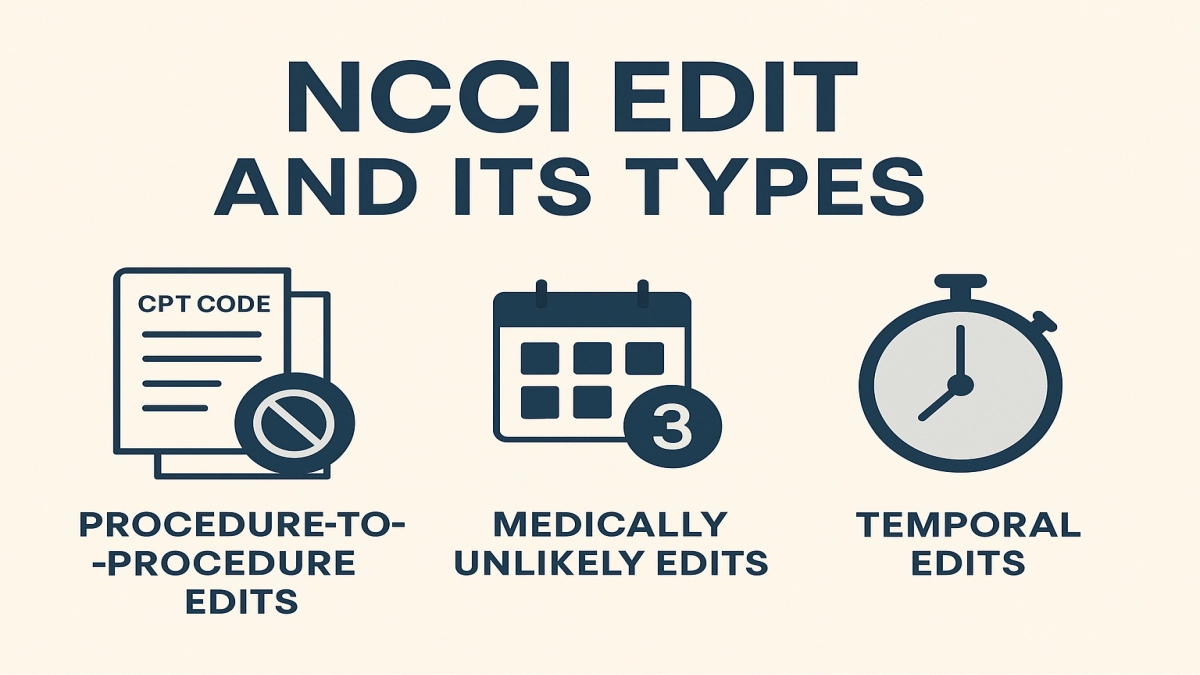The National Correct Coding Initiative (NCCI) was developed by the Centers for Medicare & Medicaid Services (CMS) to promote accurate and ethical coding. NCCI edits are automated code pair restrictions and usage limits that ensure healthcare providers do not report incompatible, redundant, or unbundled procedures on the same claim or during related episodes of care.
In essence, NCCI edits ensure that submitted claims reflect clinically logical, non-duplicative, and reasonable services based on standard coding conventions, policies, and medically accepted practice.
These edits apply primarily to claims billed to Medicare Part B, but many commercial insurers have adopted similar policies and edit systems.
Why Are NCCI Edits Important?
- Prevent overbilling and unbundling of services
- Ensure accurate reimbursement
- Support regulatory compliance with CMS guidelines
- Reduce the risk of audit exposure
- Improve first-pass claim acceptance rates
- Minimize the need for rework and appeals
Failure to understand NCCI edits can lead to systemic billing errors, increased accounts receivable days, and a drop in reimbursement accuracy—especially for high-volume practices or hospitals.
Types of NCCI Edits
There are three main types of NCCI edits, each targeting a different error risk in billing:
1. Procedure-to-Procedure (PTP) Edits
PTP edits are designed to prevent coding of procedures together that should not be reported separately. These include:
- Comprehensive/Component Edits: When one procedure (the component) is considered part of another, more comprehensive procedure.
- Mutually Exclusive Procedures (MEP): Two procedures that cannot be performed on the same anatomic site or same patient on the same day.
Real-World Example:
A provider bills CPT 45378 (colonoscopy, diagnostic) and CPT 45385 (colonoscopy with polypectomy) on the same date. Since 45378 is included in 45385, billing both would trigger a PTP edit unless a valid modifier is used.
Common Modifiers Used:
- Modifier 59 – Distinct procedural service
- Modifiers XE, XS, XP, XU – Specific alternatives to 59
Proper modifier usage must be justified with documentation—not simply added to bypass the system.
2. Medically Unlikely Edits (MUEs)
MUEs limit the maximum number of times a service or procedure can be billed per patient, per day. These edits prevent duplicate billing or over-utilization.
Example:
A provider submits 5 units of CPT 81002 (urinalysis, non-automated) on the same date. If the MUE value is 1, and there’s no clinical reason or documentation for multiple units, the system will deny the excess units.
MUEs Consider:
- Anatomical limits (e.g., humans have two kidneys)
- Typical clinical scenarios
- CMS policy benchmarks
- Specialty norms and utilization data
MUEs do not restrict the provider from performing more services, but they do limit what is reimbursed without special justification.
3. Temporal (Time-Based) Edits
This lesser-known category deals with the timing of procedures, ensuring they are clinically reasonable and not repeated inappropriately within a short timeframe.
Use Cases:
- Repeat imaging (e.g., CT scans) within 24 hours without clinical necessity
- Diagnostic tests that require recovery time before repetition
- Follow-up procedures billed too soon after initial services
Temporal edits are especially important in hospital outpatient departments and specialty clinics where repeated services are common.
Software Integration:
Modern billing systems with NCCI logic often include temporal rules that track service frequency across claim lines and flag potential violations.
Comparison Table: Key Differences Between NCCI Edit Types
| Feature | Procedure-to-Procedure (PTP) | Medically Unlikely Edits (MUEs) | Temporal (Time-Based) Edits |
|---|---|---|---|
| Primary Focus | Code combinations | Units of service | Service repetition over time |
| Based On | CPT/HCPCS code pair relationships | Clinical benchmarks & utilization data | Clinical timing logic and sequencing |
| Can Be Overridden? | Yes, with valid modifier | Rarely; requires strong justification | Occasionally, with full documentation |
| Risk of Misuse | High if modifiers used incorrectly | Moderate if clinical data misunderstood | High if EHR lacks timing integration |
| Typical Impact | Denial of one procedure | Partial denial of units | Rejection of repeated services |
| Common Example | 45378 + 45385 | 5 units of 81002 in one day | CT abdomen repeated within 12 hours |
How NCCI Edits Work in Practice
- Claim Submission: The provider submits a claim with CPT/HCPCS codes.
- Automated Editing Engine: The claim is run through an NCCI engine (either CMS or payer-adapted).
- PTP/MUE/Temporal Check: The engine analyzes all code pairs, units, and timing across dates of service.
- Edit Triggered: If an edit is triggered:
- The claim is denied or suspended.
- A modifier may be required for resubmission.
- Documentation requests may follow.
- Final Decision: The claim is paid, reduced, or denied depending on response and supporting material.
Best Practices for Managing NCCI Edits
To maintain compliance and reduce revenue leakage, incorporate the following practices:
- Integrate NCCI-aware software that includes real-time PTP/MUE/temporal edit alerts.
- Train your billing and coding team regularly on modifier use and common edit updates.
- Audit high-volume claims quarterly to identify recurring edit patterns.
- Subscribe to CMS updates for quarterly edit file releases and policy revisions.
- Establish documentation protocols for services that may require modifier overrides.
- Avoid blind modifier usage—misuse is one of the leading causes of payer audits.
Frequently Asked Questions
Is NCCI logic the same across all payers?
No. Medicare strictly follows NCCI edits, while many commercial payers use modified versions or have proprietary edit systems.
How often are NCCI edits updated?
CMS updates NCCI edits quarterly, and staying informed is essential for compliant billing.
What’s the risk of ignoring NCCI edits?
Denials, audit triggers, payment delays, and in extreme cases, fraud allegations for billing unbundled services.
Is software alone enough to catch NCCI edits?
No. While software helps, human oversight and clinical context are essential for appropriate coding decisions.

